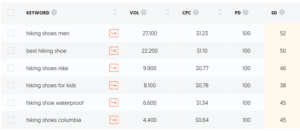7. Reaching the target audience
In the last chapters we have defined our target audience and the market. Now that we know who we want to reach and what the competitive landscape looks like, it is time to create a plan of action on how we are going to reach potential customers. To start that off, we’re going to create a keyword analysis.
Remember how we started this blog series. Don’t think from your own foundation of knowledge, but think where the company can get the highest results. If you’re an expert in advertising, but there is more potential to get conversions via organic optimizations, do the organic optimizations first.
Here’s how I like to start to get the most result out of reaching the target audience.
7.1 Keyword intent analysis
In the previous chapter we have already discussed the basics of a keyword analysis. We’ve looked at the search volume on keywords related to hiking shoes. In this keyword intent analysis, we’re going to take a look at that same list, but we’re also going to add the other columns in the image and take our keyword analysis to the next level.

In the image we see the following three different abbreviations:
CPC – Cost per click
PD – Paid difficulty
SD – SEO difficulty
Cost per click is the amount a company pays on average after someone clicked on their advertisement which shows for that specific keyword.
Paid difficulty is an indication on how many competitors are targeting that same keyword you wish to target. The more competitors that target the same keyword, the higher the PD and CPC become.
SEO difficulty is an indication for how many companies have written content containing or about the keyword. The more competition there is, the harder to rank on the first page for a given search term.
So far we have gotten more information about the keywords and how difficult it will be to rank on them through the different channels, but what we haven’t gotten to our most important component of the keyword intent analysis: the ‘intent’ part.
Intent analysis
The reason to find out about the intent for a given search term before targeting it is due to the reason that we don’t want to spend time, energy and money on keywords with a low chance to convert. Or at the very least, we do not want to start there.
We want to start targeting the keywords that have the behavior closest to the end of the customer journey. Or in other words, we first want to create content for people who are already or almost ready to buy the product/service you’re selling.
Hence, what I suggest is that you make an export of the keyword analysis from Ubersuggest or any other tool, and copy the data to an excel sheet. Add a column named “Intent” after SD and fill in how close you think a person is to being ready to buy, after having searched with that specific search term in Google. For the rating of our buy-intent I like to use the AIDA model. The AIDA model is a customer journey model, the steps are as follows: Awareness, Interest, Desire, Action.
The AIDA model
Awareness: Someone is all the way at the beginning of the customer journey. The person has an issue and is looking for a problem to solve it. In our case, someone is going on an adventurous vacation and read a blog that hiking shoes are a must have. Hence she starts searching in Google for “hiking shoes”.
Interest: The person is already aware she needs hiking shoes and reads in a blog that it is important to get hiking shoes that are waterproof. Therefore, she searches with the keywords “waterproof hiking shoes”.
Desire: As of now the person is convinced she wants waterproof hiking shoes. But which one should she choose? She returns to Google and searches for “Best affordable waterproof hiking shoes”.
Action: The person knows exactly which shoe she wants, and hence a search term of someone in the action phase is “Cheap Salomon X Ultra 3 Low GTX” or “Rei Salomon X Ultra 3 Low GTX”. In the first search term we’ve added the word ‘cheap’, which indicates that this person is (nearly) ready to buy. In the other search term we’ve added a company (Rei) name, which indicates that the person knows what and where she wants to buy.
Add the intent to all the keywords from your export in excel and sort them from Action to Awareness, so that you have all keywords that are most buy-related on top. These Action and Desire search terms are the keywords we want to start with.
Keyword Intent Analysis
The keyword intent analysis is the final list with the most important search terms for your business. You’re going to want to start preparing your business for keywords with buying intent. The further you go back in intent in the list, the more generic the keywords will become and the higher the search volume is.
In the next chapter we’re going to choose the channel that you should start with to get the most out of your important keywords. See you next week!
